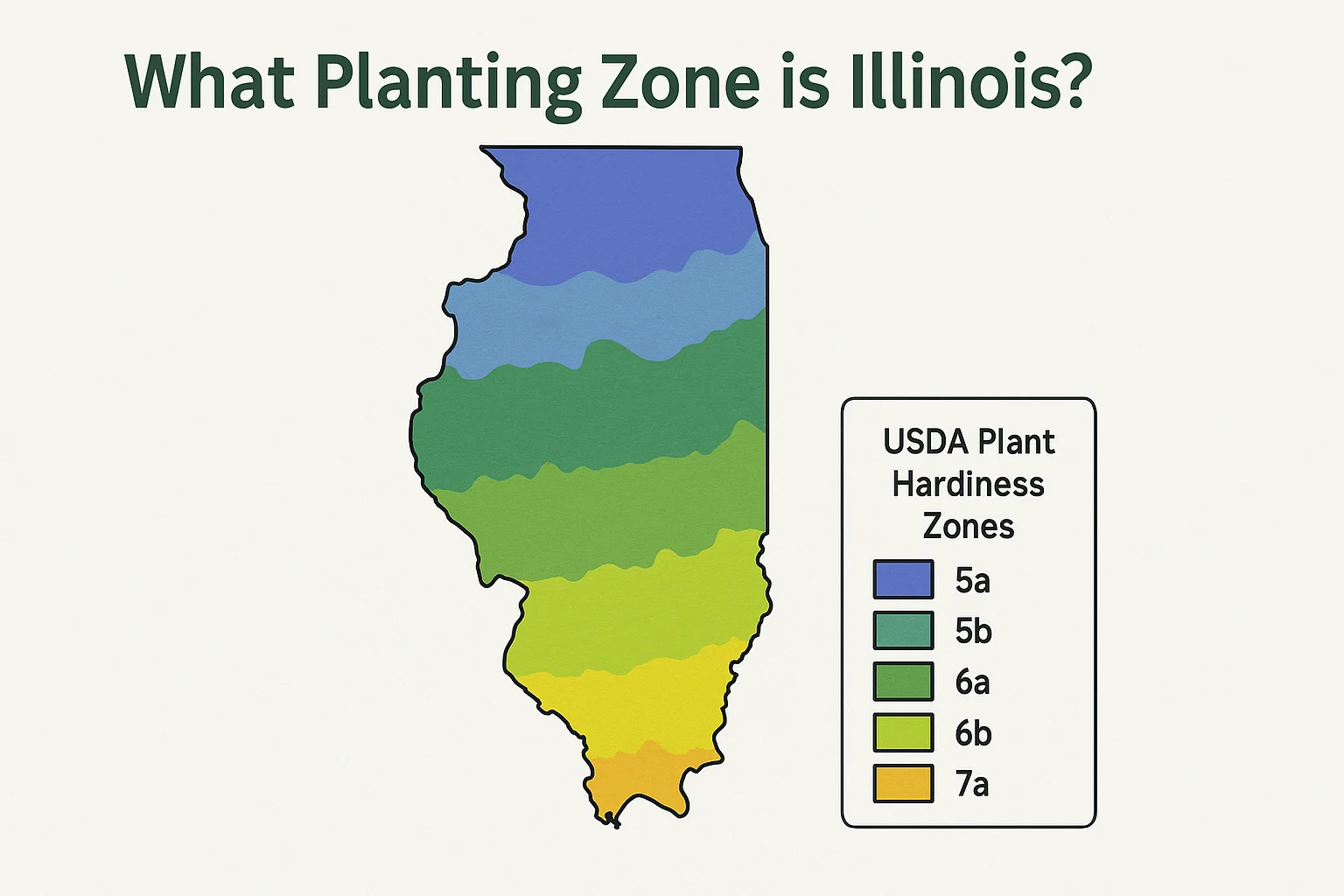What Planting Zone is Illinois?[Map, Cities, and Growing Tips]

If you’re planning to garden in Illinois, one of the first questions you’ll face is simple yet critical: What planting zone is Illinois? Knowing your USDA Plant Hardiness Zone helps you choose plants that can survive your winters and thrive through the growing season.
In this guide, we’ll cover:
- The planting zones of Illinois by region
- Why planting zones matter for gardeners
- When to plant vegetables and perennials in Illinois
- Practical growing tips for Illinois gardeners
Let’s dig in.
🌱 What Planting Zone is Illinois?
Illinois spans USDA planting zones 5a through 7a. The exact zone depends on your location within the state:
| Region | USDA Zone |
|---|---|
| Northern Illinois (e.g., Rockford, Waukegan) | Zone 5a–5b |
| Central Illinois (e.g., Peoria, Springfield) | Zone 5b–6a |
| Southern Illinois (e.g., Carbondale, Marion) | Zone 6b–7a |
So if you’re wondering what planting zone is Illinois, the answer varies. Northern Illinois is colder, while southern areas enjoy a milder climate that can support a wider variety of plants.
📍 Illinois Planting Zones by Major Cities
Here’s a quick breakdown to answer what planting zone is Illinois by city:
| City | Planting Zone |
|---|---|
| Chicago | Zone 5b |
| Rockford | Zone 5a |
| Peoria | Zone 6a |
| Springfield | Zone 6a |
| Champaign | Zone 6a |
| Belleville | Zone 6b |
| Carbondale | Zone 7a |
| Aurora | Zone 5b |
| Naperville | Zone 5b |
When people ask what planting zone is Illinois, they often get a general answer, but it really depends on your city or even your zip code.
🌡️ Why Does Illinois’ Planting Zone Matter?
Understanding what planting zone is Illinois ensures you choose plants that can handle the winter lows in your area. For instance:
- Zone 5a can experience temperatures down to -20°F.
- Zone 6a typically sees minimums around -10°F.
- Zone 7a rarely drops below 0°F.
Planting a Zone 7 perennial in Chicago’s Zone 5b could be a recipe for winter kill. On the flip side, knowing your zone allows you to confidently plant flowers, shrubs, and trees that will return each year.
📅 When to Plant in Illinois by Zone
If you’re still wondering what planting zone is Illinois and how it affects timing, here’s a simple guide:
| Crop Type | Zone 5a–5b Start | Zone 6a–6b Start | Zone 7a Start |
|---|---|---|---|
| Cool-weather crops (lettuce, broccoli) | April | March | February–March |
| Warm-weather crops (tomatoes, peppers) | Late May | Early May | April |
| Perennials & Shrubs | Early Spring/Fall | Early Spring/Fall | Fall (preferred) |
Knowing what planting zone is Illinois also helps you plan fall planting schedules and anticipate first and last frost dates.
🧠 Real-World Example: Peonies in Illinois Planting Zones
Peonies thrive in cooler climates, making them perfect for Illinois. In Zone 5b (Chicago area), they bloom beautifully but may need winter mulch. In Zone 6a (Central Illinois), they’ll flower earlier. Knowing what planting zone is Illinois helps you adjust planting times and care routines.
🌿 Growing Tips for Illinois Gardeners
If you’re gardening in Illinois, these tips can help:
- Mulch heavily in Zone 5a–5b to protect roots from deep freezes.
- Opt for cold-hardy perennials and native plants for Northern Illinois.
- Watch for soil drainage issues in spring as snow melts.
- In Southern Illinois (Zone 7a), experiment with longer-season crops.
Whether you’re growing vegetables, flowers, or trees, understanding what planting zone is Illinois will save you time, money, and frustration.
🧮 Useful Tools for Illinois Gardeners
- Soil Volume Calculator – Know exactly how much soil you need for raised beds.
- Plant Spacing Calculator – Prevent overcrowding and maximize yield.
- Indoor Plant Watering Calculator – Perfect for your houseplants or container garden.
✅ Final Thoughts: What Planting Zone is Illinois?
In short, Illinois is divided into planting zones 5a through 7a. Knowing your specific zone is crucial for successful gardening, especially for perennials and cold-sensitive plants. Before you buy seeds or shrubs, double-check your zone — it’s the first step to growing smarter in the Prairie State.
If you’re still wondering what planting zone is Illinois, use your zip code to check the official USDA Hardiness Zone Map.
